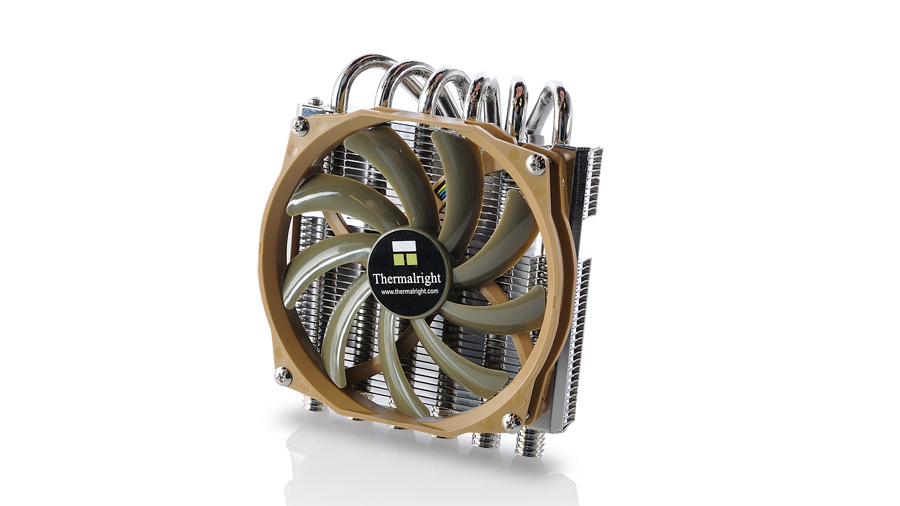TechRadar Verdict
Pros
- +
Six heatpipe design
- +
Small form factor perfect for HTPC builds
- +
Good cooling performance at load
Cons
- -
Not one for overclocking
Why you can trust TechRadar
The current crop of mini-ITX mobos, with their full-spec desktop chipsets, are just the job for building a powerful HTPC. There's a multitude of small, compact cases around to build them into, but there is a snag - how do you keep the CPU cool in a confined space?
Nine times out of 10 this means using a tower CPU cooler, which is great for keeping a CPU chilled, but not so good if you want to use as small a case as possible. Enter Thermalright and its AXP-100 compact top cooler.
Despite its mere 58mm height (including fan), it manages to cram six - yes, six - 6mm heatpipes into its design. Its compact footprint fits inside the diameter of a 140mm fan, and it supports AMD AM2/ AM3 and FM1 sockets and Intel CPUs from Socket LGA 775 up to (somewhat surprisingly) Socket LGA 2011.
The six heatpipes run through the middle of the nickel-coated copper contact plate and up through the multi-finned aluminium heatsink, where they terminate.
Installing the AXP-100 isn't quite as easy as the Noctua NH-L9i (how can you get any easier than just four screws?), but it only takes a few minutes to get it on the board. Once again, this is another cooler that needs to be mounted on the board before it goes anywhere near the case, as it uses a motherboard backing plate. You could install it in situ if you've got a chassis with a large cut-out behind the mobo, but given that it's likely to be jammed into a small form factor chassis, that's unlikely.
Before you start installing the cooler, the fan needs to come off to enable the cooler to be screwed to the mounting plate via two openings in the heatsink array. Hats off to Thermalright for the way the fan is mounted to the cooler. Instead of rubber mounts, bits of plastic or patience-sapping sprung wire setups, the fan for the AXP-100 uses four screws - simple, but very effective.
Compact chiller
The AXP-100 doesn't make a bad fist of keeping stock speed CPUs cool. Using it on our test i7 3770K, it kept the CPU temperature to a reasonable 35°C. That's not quite as cool as some of the tower coolers we've tested, but when the CPU was pushed to 100 per cent the AXP-100 actually cooled better than some chunkier models. That came as a welcome surprise - generally tower coolers comfortably out perform their top-cooled brethren.
Benchmarks
Idle CPU performance
3770K @ 3.5GHz: Degrees centigrade: Lower is better
THERMALRIGHT AXP-100: 35
NOCTUA NH-L9I: 35
REEVEN KELVEROS RC-1202: 26
100% CPU performance
3770K @ 3.5GHz: Degrees centigrade: Lower is better
THERMALRIGHT AXP-100: 68
NOCTUA NH-L9I: 76
REEVEN KELVEROS RC-1202: 69
Peak to idle performance
3770K @ 3.5GHz: Seconds: Faster is better
THERMALRIGHT AXP-100: 86
NOCTUA NH-L9I: 145
REEVEN KELVEROS RC-1202: 187
Inevitably, that flipped around with the processor overclocked. The AXP-100 managed to get within a few degrees of a bunch of tower coolers in idle mode, but when it came to running the overclocked CPU at 100 per cent, the AXP-100 cried foul, shot to over 100°C within a minute, and the testing had to be halted for the sake of our poor stressed-out silicon.
To see a cooler as compact as this using a six-heatpipe design is quite an eye-opener. It works well at stock speeds and is very quiet. It's also small enough in profile to be fitted in some very compact places, and while it isn't one for the overclocking brigade (it just can't handle it), if you're building a compact HTPC system, this excellent little cooler should be at the top of your build list.
